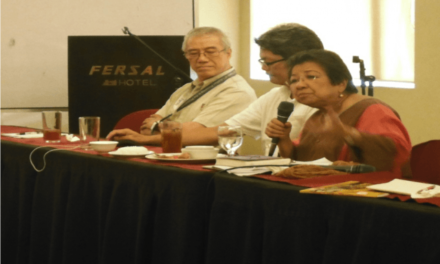By Walden Bello
originally posted on Inquirer.net
When I joined the House of Representatives a few weeks ago, I did not expect to be immediately thrust into heated debates on what have probably been the two most controversial pieces of legislation of this decade: the Constitutional Assembly resolution and the bill extending the Comprehensive Agrarian Reform Law or CARPER.
House Resolution 1109 or “Con-Ass” was not too difficult to deal with since it was pure mischief, a transparent ploy on the part of the president’s allies in the House to constitutionally legitimize her indefinite stay in power in order to keep her out of jail when, as mandated by the present charter, she leaves office on June 30, 2010.
CARPER was more complex. I voted for CARPER, reasoning that while it was not a perfect bill, it was a step forward in the long struggle for land reform in this country. It was, however, a vote taken with not a small degree of hesitation on my part and on that of many others who voted the same way.
CARP: the Record
Why CARPER was a qualified step forward cannot be understood without a dispassionate examination of the record of the original Comprehensive Agrarian Reform Program (CARP) set in motion by Republic Act 6657 in 1988. By the time it ended in 2008, the program boasted of having distributed close to 6 million of 8.1 million hectares targeted for distribution. Most land redistributed, however, were public lands. The main target of the program had been about 1.5 million hectares of private lands, and of these only 17 per cent had been transferred to tenants by 2008.
It is hard to deny that CARP fell far short of its goal, and the reasons are many. For one, its momentum was broken early on when President Corazon Aquino and her family refused to allow their huge estate, Hacienda Luisita, to be subject to redistribution to tenant farmers and workers. To avoid redistribution, the family opted for the so-called “Stock Distribution Option (SDO),” whereby tenants and workers were given shares in the plantation but real control and management remained in the hands of the family.
The SDO option was one of the many loopholes of the CARP. Aside from resorting to it, landlords subverted CARP by subdividing their land among family members instead of tenants and rural workers, selling the land to dummies or proxies, converting cropland to commercial and industrial uses to take advantage of the loopholes in the law, tying up the process in the courts, and engaging in outright physical resistance.
Certificates of land ownership (CLOA’s) were routinely challenged and beneficiaries were kept hanging as landlords remade the facts on the ground. In a number of cases, peasants who had received CLOA’s were ordered off by the authorities, even after they had already taken possession of the land and had been working it for years. Assassination of peasant activists, including prominent land-reform advocates such as Rene Penas of Pakisama and Eric Cabanit, head of Unorka, another farmers’ network, became a fact of life.
The Sumilao Famers’ March: a Turning Point
As landlords waged class war from the Bondoc Peninsula to Negros Occidental to Bukidnon, it seemed like agrarian reform was destined for the historical scrap heap when funding for CARP expired in 2008. Then there took place one of those daring actions that affect the course of history.
In November 2007, fifty five farmers demanding redistribution of 144 hectares of land they were entitled to in Sumilao, Bukidnon, made an epic 1700 kilometer march to Malacañang.
The march, led by the indefatigable peasant leader Rene Penas, brought agrarian reform back to the center of national consciousness and provided the spark for the counteroffensive against the landlord bloc’s drive to kill land reform in Congress.
It inspired many other farmers’ groups to march to Malacañang and Congress to press the cause of reform, among them the Banasi farmers, the Calatagan peasants, and the Reform CARP Movement (RCM), the broad coalition of farmers’ movements.
Church supporters were reinvigorated and new forces, like students, were brought into the fray. Put on the defensive, the landed bloc in Congress set in motion a strategy of not frontally opposing CARP but disemboweling it.
Cutting off funding for compulsory land acquisition – the sine qua non of successful agrarian reform – was the central element in the landlords’ strategy, and, in a nip- and-tuck battle in the House, their representatives nearly succeeded in doing this when they voted in mid-December of 2008 to extend CARP for six months, but without authorizing funding for compulsory acquisition of the remaining private lands.
Salvaging Reform
But, buoyed by popular support, the pro-peasant forces in Congress fought back, and over the next few months, succeeded in forcing a final debate in plenary of House Bill 4077 (the CARPER bill), the key sponsors of which were Representatives Edcel Lagman of Albay and Risa Hontiveros of the partylist Akbayan.
The climactic battle was fought in and out of Congress, as farmer organizations staged sit-ins twice at the lobby of the House of Representatives’ plenary hall and, on the final evening, broke through the North gate of the Batasan complex, leading to scuffles with the police and the arrest of nearly a hundred of them as the House debated, then approved the bill in a photo finish on the evening of June 3, before it went into recess.
The bill the House voted to approve, with only 13 in opposition, was a compromise bill that contained a couple of provisions favorable to the landlords that its leading sponsors allowed to stand for fear that the bill would not be approved before the recess owing to opposition from the landlord bloc.
“We’ll try to remove those provisions in the bicameral,” one of its sponsors told me, hoping to find allies in the delegation from the Senate.
The bicameral session sought to reconcile the House version of CARP extension with that of the Senate (SB 2666) which had been shepherded to final approval in the upper house by Senator Gregorio Honasan.
After a 12-hour marathon meeting, House and Senate participants at the bicameral signed off on the reconciled CARPER bill on June 9. Malacañang is not expected to veto it.
CARPER: Positives and Negatives
So is the final, reconciled bill, on balance, positive?
One must, of course, note, first of all, that compulsory acquisition of the remaining 1-1.5 million hectares of private land has been authorized for the next five years, with funding to the tune of P150 billion.
CARPER goes some way towards plugging the holes in the old CARP.
Mary Ann Manahan, a land reform expert with Focus on the Global South, enumerates CARPER’s key improvements over the old CARP:
It prioritizes large landholdings exceeding 50 hectares and 24-50 hectares for land acquisition and distribution during the first year of extension;
It eliminates the Voluntary Land Transfer method, which has been abused by landlords scheming to sell marginal lands at high prices, as a mode of land acquisition;
It also abolishes the notorious stock distribution option (SDO) as an acquisition option;
CARPER makes CLOA’s and Emancipation Patents (EP’s) “indefeasible,” which means once the land is registered as belonging to the land reform beneficiary, no one can say it isn’t his or hers;
Reflecting its sponsors’ realization that lack of support services has led many land reform beneficiaries having to turn over de facto ownership of the land to creditors, CARPER earmarks 40 per cent of the P150 billion budget to support services – with one-third of this amount specifically allocated for subsidies to support the initial capital or seed money for agricultural production of new agrarian reform beneficiaries, and credit facilities in the case of existing beneficiaries and leaseholders;
Prohibition of the conversion to commercial or industrial use of irrigable and irrigated lands and automatic CARP coverage of lands targeted for conversion if the conversion plan has not been implemented after five years.
But the landlord bloc, which was amply represented in the House’s contingent to the bicameral meeting, would not allow passage of the bill without the attachment of what in legislative parlance was known as a “killer amendment,” or one that would be sneaked in to obstruct the implementation of a law’s strategic aim.
This is CARPER’s Section 5 which states that “only farmers [tenants and lessees] and agricultural farm workers actually tilling the land, as certified under oath by the Barangay Agrarian Reform Council (BARC) and attested by the landowner are the qualified beneficiaries.”
The phrase “attested by the landowner” would essentially give the latter veto power over who would receive land, allowing him to, among other things, select relatives or compliant tenants as beneficiaries.
In a graphic description of the bicameral process, which was open to the public, Katarungan, a network of peasant organizations, noted that the most articulate representative of the landlord bloc, Representative Pablo (“Pabling”) Garcia, “held on to this amendment with steely resolve, even as he conceded his other ‘killer amendments’ and allowed the passage of reforms.”
Not even the slaying of the popular peasant advocate from Sumilao, Rene Penas, shortly before the bicameral began, softened the determination of the landlord lobby to retain this clause.
Why? Because it would make the agrarian reform process “hostage” to “an entity whose interest is precisely to stop the process.”
According to Katarungan, Section 5 would allow “much havoc to be wrought.”
The pro-farmer participants at the bicameral were well aware of the amendment’s potential for mischief, and they succeeded in inserting a clause that would hold “criminally liable” and penalize “any person who shall cause undue delay of the implementation of the program.” Many feel, however, that this will be insufficient to deter landlords determined to derail the process.
No Easy Choices
The battle over CARPER went down to the wire. It was class politics taking the form of rough legislative struggle and maneuver, and in the end, the pro-reform forces were forced to choose between passing a bill many provisions of which were a significant improvement over CARP but which carried one menacing provision, and seeing the agrarian reform process stall.
I believe that given the balance of forces in the country today, those who voted for CARPER made the right choice. This was the best piece of agrarian reform legislation we could come up with at this historical juncture, given the correlation of class power. But the contingency element looms large: whether CARPER becomes truly a vehicle for advancing reform will depend on whether pro-reform forces can create, at the local level, the critical political mass involving farmers, progressive elements at the Department of Agrarian Reform, the Church, and other groups that would overcome the rearguard actions of the landed class to delay the inevitable.
To paraphrase an old legal saying, the facts on the ground will constitute nine-tenths of the law.
*The commentator is one of the two members of Congress representing the partylist Akbayan! (Citizens Action Party).








